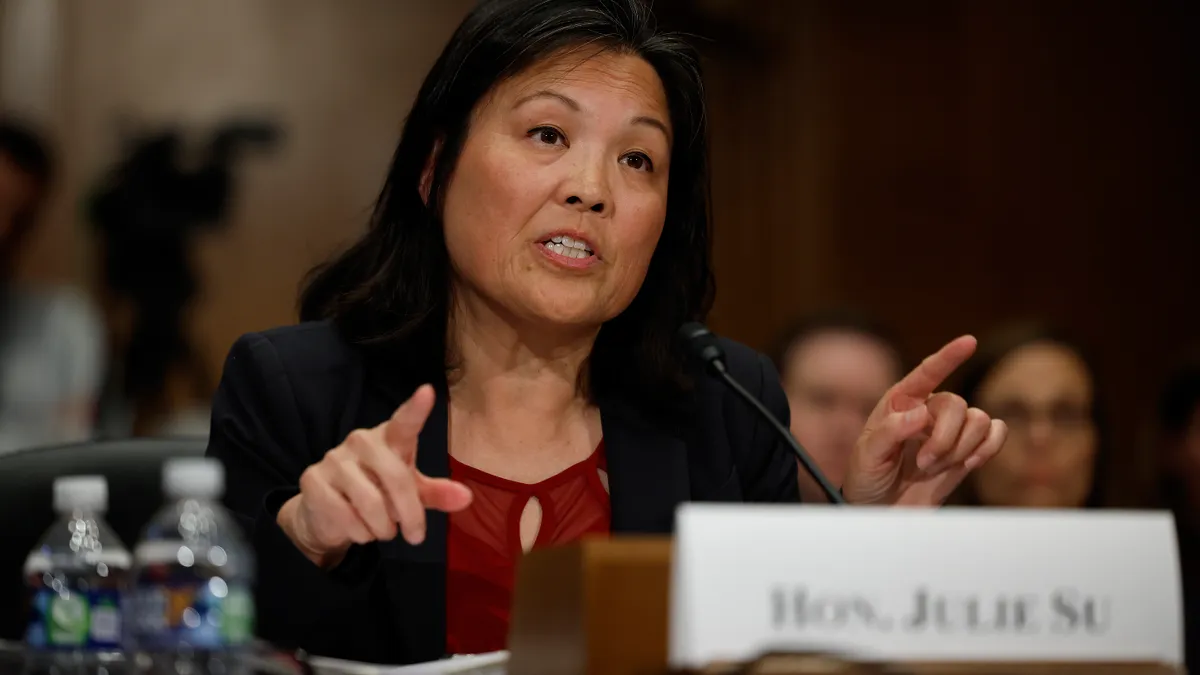Dive Brief:
- Attorneys representing the Department of Labor and challengers opposing its rule allowing pension fund managers to consider ESG factors in investments presented their oral arguments before the U.S. Fifth Circuit of Appeals Tuesday.
- The lawyer for the plaintiffs — which include 26 Republican state attorneys general, a Liberty Energy subsidiary and an energy trade group — argued that the agency’s guidance around its “tiebreaker standard” in the rule violates the requirement for fiduciaries laid out in the Employment Retirement Income Security Act of 1974. The Labor Department’s lawyer disagreed with the view that managers’ fiduciary duties were exhausted and argued ERISA is silent on the matter of a true tiebreaker, which is why the agency has issued such guidance since 1994.
- The case was initially dismissed by a U.S. District Court in September, with a decision that relied upon the recently overturned Chevron doctrine. While the Labor Department did not rely on Chevron in its appeal argument, both lawyers signaled varied openness to the possibility of the case being returned to the District Court, in light of the Supreme Court’s ruling on the doctrine.
Dive Insight:
The case centers on a provision contained within the Labor Department’s 2022 rule, “Prudence and Loyalty in Selecting Plan Investments and Exercising Shareholder Rights.” The regulation, which has been in effect since January 2023, allows pension fund managers to consider ESG factors only in the case where two or more investments “equally serve the financial interests of the plan over the appropriate time horizon.”
The tiebreaker standard, which was first issued by the Labor Department in 1994, initially laid out what fiduciaries should do in a situation where two or more investments are “commensurate” and it is imprudent — either through monitoring costs or other restrictions — to invest in both, or all options. The Labor Department’s lawyer made clear Tuesday that the 2022 revision changed that language to be applicable only in situations where multiple options are “absolutely equal” in financial respects. In other words, if one investment is expected to bring back even an additional cent in return, the two options are not equal.
Jonathan Berry, a managing partner for Boyden Gray PLLC representing the plaintiffs, argued in court that by including such a tiebreaker standard, allowing for non-pecuniary factors to be considered, it creates a subordinate loyalty beyond fiduciaries’ ERISA duties to act “solely” and for the “exclusive purpose” of the plan.
“The concept behind the tiebreaker is that the duty of loyalty is essentially exhaustible,” Berry said Tuesday. “That once prudence has narrowed the options down to two things that are, as we would argue, economically indistinguishable, the fiduciary has broader reign.”
Daniel Winik, a Department of Justice lawyer representing the Labor Department, disagreed with this interpretation of the tiebreaker standard but said that the scope of the parties’ disagreements are relatively narrow.
Winik disagreed with the idea of fiduciary duties running out and maintained that whether a fiduciary were to flip a coin or look at other “collateral benefits” such as ESG factors, both actions would be in line with their fiduciary duties because at that point the manager would have already done their due diligence in determining that each option would be the exact same in terms of pure pecuniary factors over the relevant time span for the plan.
“Whichever of the options you pick, you are serving the financial interests of the plan,” Winik told the judges Tuesday. “That's why you're complying with your fiduciary duties.”
With respect to Chevron, Allen said that under the Loper Bright Enterprises v. Raimondo ruling that eliminated the doctrine, the Labor Department’s 1994 guidance establishing the tiebreaker is not sufficient to grant the executive branch deference because it was first issued two decades after the rule.
Allen said he would be willing to try the case before the Texas Northern District Court again, should it be remanded. Though he added that given the lower court also ruled that the regulation was not unnecessary nor “arbitrary and capricious,” he does not “see anything in [the initial dismissal] that would incline the District Court to revisit much of its opinion in light of its reliance on Chevron.”
Winik said he “doesn’t have a huge problem” with the idea of re-arguing the case before the lower court, but he believes “the logic of the District Court's opinion would produce the same result” under the Loper Bright decision.
Shortly after the initial dismissal was announced in September, the 26 Republican state attorneys general responsible for the original lawsuit filed the appeal and signaled a willingness to take their fight as high as the U.S. Supreme Court. The lower court’s reliance on Chevron was notable at the time, as Loper Bright worked its way through the Supreme Court docket, before ultimately overturning the philosophy that courts should grant deference to agencies to interpret ambiguous statutes.
Liberty Oilfield Services — a subsidiary of Colorado-based onshore oil and natural gas services provider Liberty Energy — and energy trade association Western Energy Alliance joined the appeal in January. Liberty Energy is also a current challenger to the Securities and Exchange Commission’s climate-risk disclosure rule facing petitions in the U.S. Eighth Circuit of Appeals.
The Department of Labor’s case is now under consideration by Circuit Court Judges Catharina Haynes, Don Willett and Andrew Oldham.
Correction: In a previous version of this article, Daniel Winik's name was misspelled.











